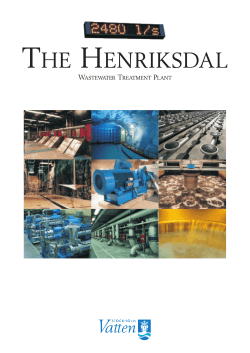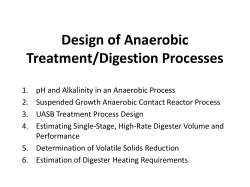
SAMRA WASTEWATER TREATMENT PLANT
DEGREMONT_SAMRA_PLAQUETTE:Layout 1 11/08/08 17:35 Page 1 RÉF. R-ER-020-EN-0808 RÉALISATION : LES ÉDITIONS STRATÉGIQUES - 08/2008 SAMRA WASTEWATER TREATMENT PLANT JORDAN DEGREMONT_SAMRA_PLAQUETTE:Layout 1 11/08/08 17:35 Page 2 SAMRA WASTEWATER TREATMENT PLANT JORDAN PROJECT OVERVIEW THE WASTEWATER MANAGEMENT SYSTEM FOR THE GREATER AMMAN AREA INCLUDES THE COLLECTION, CONVEYANCE AND TREATMENT OF THE WASTEWATER GENERATED IN THE AMMAN RUSSEIFA–ZARQA BASIN, WHERE 60% OF THE POPULATION OF JORDAN LIVE. Samra wastewater treatment plant project is: • a public private partnership (ppp) for financing the construction and operation of a public infrastructure in Jordan based on a Build Operate Transfer approach over a period of 25 years. • the first (BOT) project in Jordan. • the first (BOT) project by USAID. • a crucial element in its social, environmental and economical development. The Swedish International Development Agency (SIDA) financed the technical assistance during the preparation phase, construction, commissioning and 18 months of the commercial operation period of the project. The consulting company is SWECO. PROJECT FINANCING 169 MILLIONS USD This is the Project budget financed by the following partners: 78 USAID 60 BANK CONSORTIUM SAMRA PLANT CONSORTIUM (Suez Environnement, Infilco Degremont Inc. & The Morganti group) GOVERNMENT OF JORDAN - MWI 17 14 PROJECT CHARACTERISTICS • Provides a state of the art of wastewater treatment. • Replaces an overloaded waste stabilization pond treatment system. • Produces an effluent with a quality meeting the Jordanian Standards. • Allows safe reuse of treated water for agriculture. • Eliminates offensive odors in the surrounding area. • Will develop the production of compost and fodder from the digested sludge. • Use the biogas produced in the sludge digesters to generate thermal and electrical power. • Use the hydraulic potential energy at the inlet and outlet of the plant to produce electricity. DEGREMONT_SAMRA_PLAQUETTE:Layout 1 11/08/08 17:35 Page 3 DESIGN FIGURES PHASE 1 DESIGN PARAMETERS 2 phases were planned for this project. The actual plant design and construction is for the first stage (2015), making provision for its expansion to the second phase (2025). PARAMETER PHASE 1 PHASE 2 2.27 3.3 267,000 420,000 Population in Millions 3 Dry Weather Flow m /d Flow / inh. Liters/day 118 127 RAW WATER QUALITY BOD5 652 mg/l Grease 30 m3/d COD 1,449 mg/l H2S 40 mg/l TSS 551 mg/l Nematodes 5 eggs/l VSS 440 mg/l F- Coliforms 10 8 MPN/100 ml TN 130 mg/l EFFLUENT WATER & SLUDGE QUALITY BOD5 30 mg/l F-Coliforms < 1000 MPN/100ml TSS 30 mg/l Nematode Eggs < 1 egg/l TN 30 mg/l Fat, Oil & Grease < 8 mg/l pH 6-9 Dry Solids 30% DO > 2 mg/l PROCESS DESCRIPTION RAW WATER FROM AIN GHAZAL PRETREATMENT FACILITY FLOWS THROUGH A Ø1,500 mm PIPE INTO TWO PELTON TURBINES IN THE INLET STRUCTURE WHERE ELECTRICAL POWER IS GENERATED.THE NET HEAD BETWEEN AIN GHAZAL AND SAMRA IS AROUND 78 m. The outlet joins the incoming wastewater from Zarqa and Hashimiyya pumping stations and distributed into two grit and sulfide removal tanks each divided into two chambers: • A Grit Removal tank (19.6m x 13.0 m) with a volume of 1,560 m3 and an average hydraulic residence time (HRT) of 17 minutes. Air is introduced at the bottom of the grit chamber causing heavy particles to settle and is collected by a screw and discharged into the grit classifier. Air bubbles will cause oil, grease and scum to float on the surface. It is then collected in a scum pit and pumped to the digesters. • A Sulfide Removal tank consisting of 2 aerated zones inseries each of capacity 2,500 m3. Ferric Chloride is injected here as a catalyst for the sulfide removal. The effluent from the sulfide removal tanks is distributed into four primary settling tanks each is 67 m long and 25 m wide. These tanks remove about 65% of the total suspended solids and 40% of the BOD5. The oil and grease are skimmed and collected in the scum chamber. The settled water from the primary settling tanks is distributed into eight biological reactors each of a total volume of 26,200 m3 consisting of three zones: • Anoxic zone for exogenous denitrification (V= 6,875 m3) • Oxic zone where air is introduced continuously through air diffusers to remove BOD5 and initiate nitrification (V= 10,825 m3) • Endogenous zone where air is introduced intermittently for complete nitrification (V= 8,500 m3). The effluent of the activated sludge process is distributed into eight secondary clarifiers each of Diameter 54 m. Bio suspended solids are separated and the settled sludge thickened and returned to the anoxic zone of the aeration tanks. The clarified effluent of the secondary settling tanks flows to two plug flow chlorine contact basins each of a volume of 3,500 m3 where it will be in contact with chlorine for about 35 minutes for its final disinfection meeting the Jordanian Standards 893/1995. DEGREMONT_SAMRA_PLAQUETTE:Layout 1 11/08/08 17:35 Page 4 SAMRA WASTEWATER TREATMENT PLANT JORDAN SLUDGE TREATMENT Primary sludge from the primary settling tanks is thickened in three covered circular thickeners each of diameter 23 m. Biological sludge from the aeration tanks is thickened in another three covered Dissolved Air Flotation units (DAF) of diameter 18 m. The two are mixed together in a covered tank of 98 m3 volume before it is pumped to four anaerobic digesters each of capacity 15,900 m3. BIOGAS TREATMENT The Biogas produced in the digesters is stored in two gas holders each of 5,000 m3 capacity. It undergoes H2S removal before being used in five Biogas engine generator sets for the production of electricity. From Ain Ghazal Ø1500 3 2.5 m /s Pelton Turbines 3 2.5 m /s General Odour Control System From Zarqa Ø1200 From Hashemiyya 2 x Ø500 FeCl3 Na OH Biogas Desulfurization Desulfurization Odour Control Units Scum Sulfide Removal The digested Sludge flows to the digested sludge storage tank where it is pumped to 25 solar evaporation basins where it is dried to about 30% dry solids. Lime will be used if necessary for sludge stabilization. Waste Gas Burners From Hashemiyya 2 x Ø500 The sludge is kept in the digesters for three weeks at 35ºC where it is mixed thoroughly by the Cannon®Mixers using the recycled compressed biogas. Heating of the recycled sludge is done by hot water recovered from the cooling of the engines in a shell-Tube heat exchanger. Biogas Holders From Zarqa Ø1200 Grease Separation Grit Gas Power Generation Units Air Air Grit & Sulfide Removal Units Scum Digesters Primary Settling Tanks 35°C Primary Sludge Thickeners Scum Primary Sludge Thickener Mixing Tank Boilers Sludge Recycle Sludge Recycle Aeration Tanks Zone 1 Anoxic Zone 2 Oxic Exogenous BOD Removal Endogenous De-Nitrification De-Nitrification De-Nitrification 2 The plant is designed to ensure that no odor nuisance occurs at the site boundary. Odors are extracted in different places of the plant preventing the emission of unpleasant smells, providing satisfactory working conditions. Air 11 Dissolved Activated Sludge Flotation units Sludge Tank Solar Evaporators Air POWER PRODUCTION PeltonTurbines Francis Turbines Biogas Power Generator Secondary Clarifiers 1.710 MW 1.640 MW 5.375 MW ------------------ TOTAL 8.725 MW Francis Turbines Cl2 Cl2 Chlorination To Wadi Dhuleil The process consists of treating polluted air in a scrubber system containing a special inert medium, the Biolite in which naturally present bacteria are fixed. Water is pulverized periodically on top of it absorbing the polluting gases. The treated air in the lower part of the scrubber is collected and discharged to the atmosphere. DEGRÉMONT JORDAN DAOUD KHOURY 57, BAONIAH STREET JEBEL WEIBDEH - AMMAN - JORDAN MOBILE : 00 962 795 50 45 77 DAOUD.KHOURY@INFILCODEGREMONT.COM DHKHOURY@GO.COM.JO PROJECT KEY FIGURES Total Concrete Poured 98,500 m3 Concrete-reinforcing steel 12,500 Tons Total Length of Electrical Cables 487 Km Installed Electrical Power 14 MW Stainless Steel Pipes 600 Tons Carbon Steel Pipes 180 Tons Underground GRP Pipes 15.4 Km Other Pipes (Galvanized,PVC,HDPE) 14.2 Km Peak Labor Force on site 1950 O&M Labor Force 150 RÉF. R-ER-020-EN-0808 RÉALISATION : LES ÉDITIONS STRATÉGIQUES - 08/2008 ODOR CONTROL 3 Zone 3 Endogenous
© Copyright 2025





















